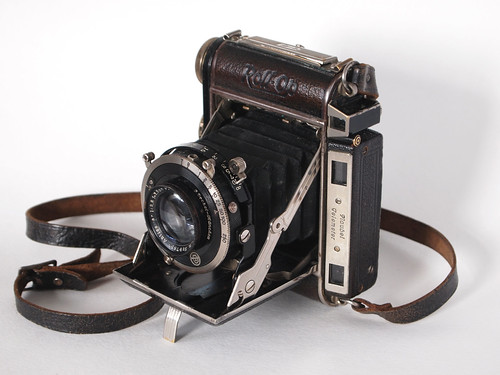 |
| Plaubel Roll-Op II (6x4.5cm version) |
Plaubel was one of the many German camera manufacturers started in the early 20th century. The company made their name with the
iconic Makina, a strut-folding camera for plates and sheet film which went through many iterations over half a century. Plaubel was then sold to a Japanese buyer which produced medium format rangefinder cameras under the
Makina name, which now command high prices secondhand.
The
Roll-Op was Plaubel's more conventional medium format folding camera, a cheaper alternative to the Makina. There were both 6x6cm and 6x4.5cm versions. The camera's name is sometimes written 'Rollop', although on the camera itself the leather is imprinted 'Roll-Op' (
this advert shows it written 'Rollop', so the name's different constructions seem to have been used interchangeably; there was a completely different camera by Lipca named the
'Rollop'). The Roll-Op article on Camera-wiki describes the original model with a reference to McKeown's, but the only examples of the camera that appear online are those of the second model, the rangefinder Roll-Op II. The camera body is actually that of the
Balda Baldax with the rangefinder and lens assembly added by Plaubel. The rangefinder itself, the Plaubel Telemeter, comes from the Makina, and is coupled to the lens, which is unit focused.
For a folding camera from the mid-1930s, the Roll-Op's distinctive features are its automatic frame counter, rangefinder, and the fast 75mm f2.8 Anticomar lens. The automatic frame finder is the same design that Plaubel used for medium format roll-film backs (
seen here on Early Photography). This requires the first frame number to be lined up with the red window on the back of the camera manually, and the frame counter on the body turned to '1'. After each exposure, the pivoting lever has to be released to advance the film, and the lever then catches a notch to stop the film at the required distance for the next frame. As the advance is not linked to the shutter, and the catch has to be released after each frame, it feels more like a 'semi-automatic' operation, essentially removing the need to watch for the frame numbers in the red window while advancing the film.
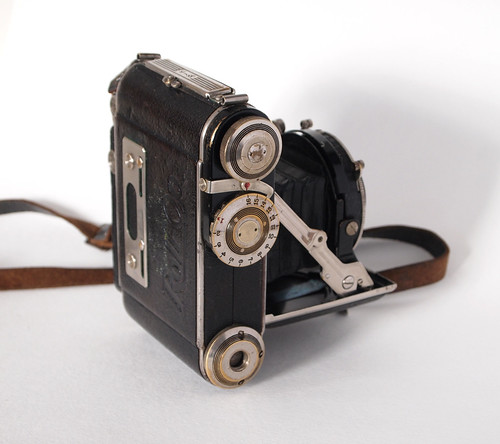 |
| Plaubel Roll-Op II, showing frame counter |
The rangefinder is coupled to the lens with unit focus and is a split window type, showing a limited angle of view, essentially cropped, due to the way the rangefinder is constructed: there are no lenses in its construction, only two mirrors, meaning that the split image is not reduced but life-size. There is a separate telescopic viewfinder positioned next to the rangefinder window which shows the lens' true angle of view. In operation, the rangefinder is used to accurately focus the lens, then the viewfinder window is used to compose the shot, which makes using the rangefinder slower than more modern types with a beamsplitter where the rangefinder image is superimposed inside the viewfinder.
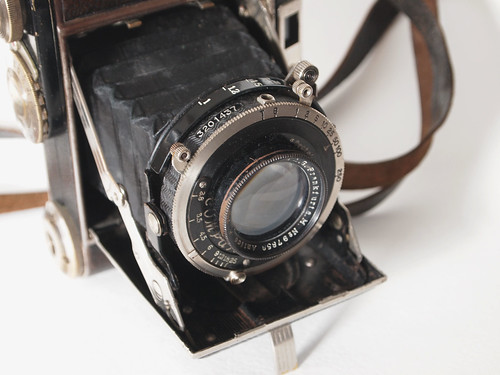 |
| 75mm f2.8 Anticomar lens, in Compur shutter |
The Anticomar lens used on the Roll-Op is the same lens as that developed for Plaubel's Makina. Important for me was that the f2.8 Anticomar was fast for a 1930s' medium format camera (most of my other medium format folding cameras have f4.5 lenses), which makes the Roll-Op better for hand-held low-light situations. There are differing views of the Anticomar, a four-element Tessar-type, which seems to have qualities typical of 1930s lens. In the example immediately below, shot on Ilford Delta 100, the image is acceptably sharp, but with a suggestion of flare from the bright sunlight patch of wall in the centre of the image, and a falling off of focus towards the edges of the frame (the view of rooftops lower down may be a better image from the lens stopped down further). However, with the aperture wide open, the image is relatively soft, as seen in the second image below. I've read somewhere online, in a reference that I cannot now find, that the Anticomar lens was
designed to be soft when wide open for portraiture, to achieve the soft focus look popular in the 1930s. This may be just an apocryphal theory to excuse the Anticomar's shortcomings.
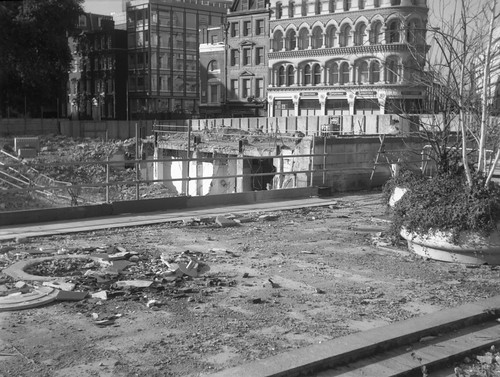 |
| Plaubel Roll-Op II with Ilford Delta 100 |
 |
| Plaubel Roll-Op II with Fomapan 400 |
Although the Roll-Op is a fairly solid camera with the weight to match, I managed to break the
advance mechanism twice, the first time almost
immediately after I'd loaded the first roll of film into the camera. I lost the advance knob while boarding a train: I'd had the camera over one shoulder and the knob may have been loose, and knocking it against the back of a train seat was enough. It was still possible to advance the film, but hard on the nails to turn the small square-section peg that the advance knob would have been fixed to. However, I needed needle-nosed pliers to pull this out in order to remove the film from the camera once shot. Some months later, the shell of a Roll-Op without lens or rangefinder appeared on a well-known auction site, and as this had the original advance knob, I was able to use this to repair my camera. Around a
year later, I dropped the camera, and the advance knob simply sheared off this time, so, reluctantly, I sold on
the broken camera for repair.
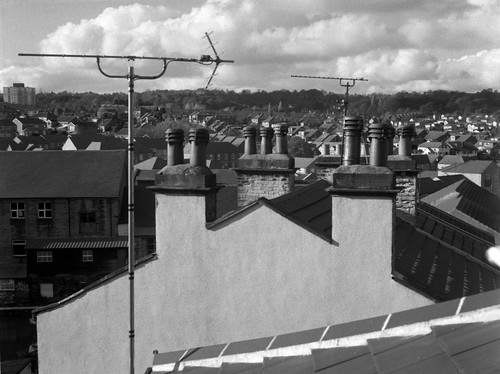 |
| Plaubel Roll-Op II with Fomapan 400 |
 |
| Plaubel Roll-Op II, with Fomapan 400 |
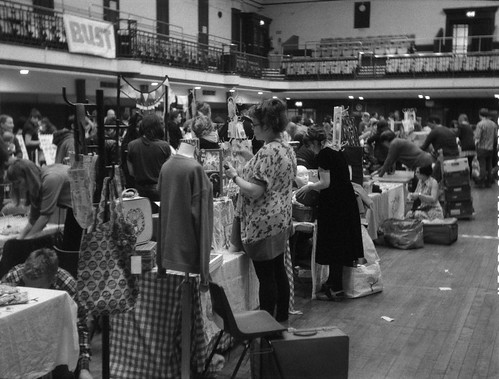 |
| Plaubel Roll-Op II with Ilford Delta 3200 |
Sources/further reading:
Plaubel Roll-Op on Camera-wiki
Roll-Op II on Early Photography
Plaubel company history on J. Noir's Classic Cameras







